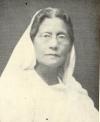Kamini Roy poet from Bangladesh was born on October 12, 1864, had 69 years and died on September 27, 1933. Poems were written mainly in Hindi language. Dominant movement is other.
Biography
Kamini Roy (Bengali: ?????? ????) was a leading Bengali poet, social worker and feminist from India. She was the first woman honours graduate in India.
Early Life
Born in the village of Basanda, then in Bakergunj district of East Bengal and now in Barisal District of Bangladesh, she passed the entrance examination in 1880 from Bethune School, established by Bethune at Kolkata, and first arts in 1883. A part of the earliest batch of girls to attend school, she was the first woman honours graduate in the country, having passed her bachelor of arts degree with Sanskrit honours from Bethune College of the University of Calcutta in 1886. Kadambini Ganguly was three years senior to her in the same institution. She continued her association with Bethune College as a teacher.
She hailed from a family of elite Bengal. Her father, Chandi Charan Sen, a judge and a writer, was a leading member of the Brahmo Samaj. Nisith Chandra Sen, her brother, was a renowned barrister in the Calcutta High Court, and later the Mayor of Calcutta. Another sister, Jamini was the house physician of the then Nepal Royal family. In 1894 she married Kedarnath Roy.
She was inclined towards literature from a young age and started composing poems at the age of eight. Her first book of poems, Alo O Chhaya, was published in 1889.
Feminist Movement
Kamini Roy was a feminist in an age when even women's education was a taboo. She picked up the cue for feminism from a fellow staudent of Bethune School, Abala Bose. In an address delivered at a girls' school in Calcutta she declared that the aim of women's education was to contribute to their all-round development and fulfilment of their potential.
In a Bengali essay titled The Fruit of the Tree of Knowledge she wrote,
?The male desire to rule is the primary, if not the only, stumbling block to women?s enlightenment... They are extremely suspicious of women?s emancipation. Why? The same old fear -?Lest they become like us?.?
In 1921, she was one of the leaders, along with Kumudini Mitra (Basu) and Mrinalini Sen of the Bangiya Nari Samaj to fight for woman?s suffrage. Limited suffrage was granted to women in 1925, and in 1926 Bengali women exercised their right for the first time. She was a member of the Female Labour Investigation Commission (1922-23).
Later Life
She went out of her way to encourage other writers and poets. In 1923, she visited Barisal and encouraged Sufia Kamal, then a young girl, to continue writing. She was president of the Bengali Literary Conference in 1930 and vice-president of the Bangiya Sahitya Parishad in 1932-33.
Kamini Roy lost her husband in 1909. Her intense grief and pain over his premature death deeply affected her personal life and was reflected in her poems. She was influenced by the poet Rabindranath Tagore and Sanskrit literature. Calcutta University honoured her with the Jagattarini Gold Medal.
In her later life, she lived at Hazaribagh for some years. In that small town, she often had discussions on literary and other topics with such scholars as Mahesh Chandra Ghosh and Dhirendranath Choudhury. ..






